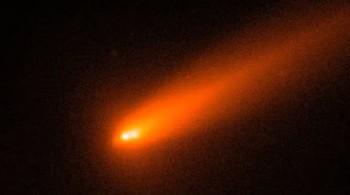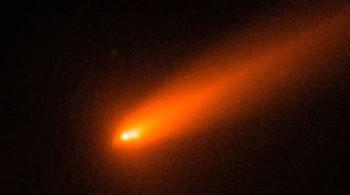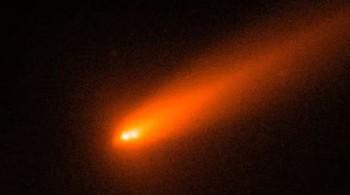
Comet C/2025 K1 (ATLAS) breaks into 3 after coming close to Sun
In a fascinating astronomical event, Comet C/2025 K1 (ATLAS) has broken into three pieces after swinging too close to the Sun. This rare occurrence was captured by astronomers using Italy’s Copernicus telescope, providing a unique glimpse into the comet’s dynamics. The comet’s nucleus became unstable after it passed close to the Sun on October 8, resulting in a spectacular fragmentation.
Comet C/2025 K1 (ATLAS) was first discovered in May 2025 by the Asteroid Terrestrial-impact Last Alert System (ATLAS) survey. Since then, astronomers have been closely monitoring its approach to the Sun, anticipating a potentially spectacular display. As the comet drew closer to the Sun, its ices began to vaporize, creating a bright tail of gas and dust. However, the intense heat and gravitational forces exerted by the Sun proved too much for the comet’s nucleus, causing it to break apart.
The stunning images captured by the Copernicus telescope reveal two large chunks of the comet’s nucleus drifting approximately 2,000 km apart. A smaller, third piece can be seen to the left of the pair, highlighting the comet’s disintegration. This event is a rare opportunity for astronomers to study the internal structure and composition of a comet, providing valuable insights into the formation and evolution of our solar system.
The fragmentation of Comet C/2025 K1 (ATLAS) is not entirely unexpected. Comets are known to be fragile and prone to breakups, especially when they approach the Sun. The intense heat and radiation emitted by the Sun can cause the ices within a comet to vaporize rapidly, leading to a buildup of pressure and eventual fragmentation. In this case, the comet’s close approach to the Sun on October 8 appears to have triggered the breakup.
Astronomers are eager to continue monitoring the comet’s fragments, hoping to learn more about the comet’s internal structure and composition. The study of comets like C/2025 K1 (ATLAS) can provide valuable insights into the early formation and evolution of our solar system. By analyzing the comet’s fragments, scientists can gain a better understanding of the materials and processes that shaped our cosmic neighborhood.
The breakup of Comet C/2025 K1 (ATLAS) is also a reminder of the dynamic and unpredictable nature of our solar system. Comets, in particular, are known for their unpredictability, and their behavior can be influenced by a variety of factors, including the Sun’s gravity, solar wind, and the comet’s own internal structure.
As astronomers continue to study the fragments of Comet C/2025 K1 (ATLAS), they may uncover new and exciting information about the comet’s composition, size, and shape. The study of comets like C/2025 K1 (ATLAS) can also help scientists better understand the potential risks and opportunities associated with comets, including the possibility of comet impacts and the potential for comets to deliver valuable resources to Earth.
In conclusion, the breakup of Comet C/2025 K1 (ATLAS) is a significant astronomical event that offers a unique glimpse into the dynamics of comets. The fragmentation of the comet’s nucleus provides a rare opportunity for scientists to study the internal structure and composition of a comet, shedding new light on the formation and evolution of our solar system. As astronomers continue to monitor the comet’s fragments, they may uncover new and exciting information about the comet’s composition, size, and shape, further expanding our understanding of the cosmos.






